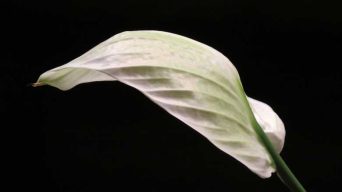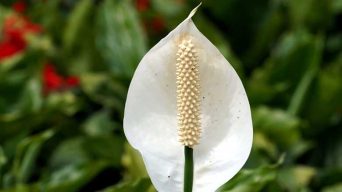There can be several reasons why the leaves of a Peace Lily are turning yellow. It could be due to overwatering, underwatering, inadequate sunlight, nutrient deficiencies, or even pests. To address this issue, ensure you water the plant appropriately, provide sufficient indirect light, fertilize it as needed, and monitor for any signs of pests.
Seeing your Peace Lily plant’s lush, green leaves turn yellow can be a heart-stopping moment for any plant enthusiast. However, there’s no reason to panic just yet.
Your verdant companion could communicate various issues, ranging from over-watering to insufficient light.
Here, we unravel the mystery behind the yellowing of Peace Lily leaves and arm you with actionable solutions to address the problem and keep your plant thriving in optimal health.
Facts and Statistics
- According to a study by the University of Maryland Extension, inappropriate watering—either too much or too little—accounts for approximately 30% of all indoor plant health problems, such as yellowing leaves in Peace Lilies.
- Research from Florida University suggests that up to 50% of Peace Lilies can develop yellow leaves if exposed to light intensities above 1000 foot candles – much higher than their preferred range of 200-500 foot candles.
- Studies have shown that Peace Lilies typically absorb water at a rate of about one inch per week, and thus, any deviation from this amount can disrupt their nutrient balance and cause signs of distress like yellow leaves.
Reasons Why Peace Lily Leaves Turn Yellow
The sight of yellow leaves on your beloved Peace Lily can be concerning, but fear not! Several common causes for this issue can be easily addressed.
By identifying the root cause, you can take the necessary steps to return your Peace Lily to its vibrant and healthy state.
One possible cause of yellow leaves is improper watering. Overwatering or underwatering can both lead to yellowing foliage. If the soil is constantly wet or waterlogged, it’s a sign of overwatering.
On the other hand, if the soil feels dry and the plant appears wilted, it may indicate underwatering. It’s important to strike a balance by watering your Peace Lily thoroughly but allowing the top layer of soil to dry out before watering again.
Another factor to consider is the quality of water you use. Tap water with added minerals and fluoride can affect sensitive plants like Peace Lilies.
Consider using distilled or rainwater, or let tap water sit out overnight to reduce the concentration of additives that could potentially harm the plant.
Lighting conditions also play a significant role in the health of a Peace Lily. These plants prefer bright but indirect light.
Placing them close to an east-facing window or a few feet from a southern or western window with natural shade is ideal. If your Peace Lily is exposed to direct sunlight, it can cause sunburn and yellow leaves.
Furthermore, deficiencies in essential nutrients can manifest through yellow leaves with pale areas surrounding veins.
Nitrogen, iron, or magnesium deficiency could be contributing factors. This is where fertilization comes into play. Fertilize your Peace Lily every six weeks during spring and summer growth using a balanced houseplant fertilizer.
However, pause fertilizing in fall and winter when the plant’s growth slows.
Weakened plants are more susceptible to pests like spider mites, scale, and mealybugs. These pests can cause yellowing leaves.
Regularly inspect your Peace Lily for any signs of infestation and take appropriate action to remove them manually or seek professional help if necessary.
It’s important to note that natural aging can also cause older leaves at the bottom of the plant to turn yellow. These leaves naturally drop off, but you can remove them with clean pruning shears.
Now that we have explored the various causes of yellow leaves in Peace Lilies let us delve into the impact of environmental and soil conditions on these beloved plants.
Environmental and Soil Conditions
Peace Lilies are resilient plants that still require specific environmental conditions to thrive. When it comes to their preferred habitat, they enjoy a warm and humid environment mimicking their native tropical rainforest settings.
Peace Lilies prefer temperatures between 68-85°F (20-29°C). Extreme cold or hot temperatures can stress the plant and lead to yellowing.
Ensure your Peace Lily is kept from drafts or direct exposure to heating or cooling vents.
The soil composition is equally crucial. Peace Lilies prefer a well-draining potting mix that retains moisture without becoming waterlogged.
A mixture of peat moss, perlite, and bark is ideal for adequate drainage while retaining enough moisture for the plant’s needs.
In addition to proper soil composition, selecting an appropriate pot for your Peace Lily is essential. If the pot is too small, it can restrict root growth and lead to root-bound plants, resulting in yellow leaves. Ensure that the pot has drainage holes so excess water can flow out.
Humidity levels also affect Peace Lilies’ health. Dry indoor environments can lead to brown leaf tips and yellowing foliage. To increase humidity, consider using a humidifier or placing the Peace Lily on a tray filled with water and pebbles, ensuring the bottom of the pot does not sit in water.
By understanding the impact of environmental and soil conditions, you can create an optimal growing environment for your Peace Lily, reducing the chances of yellow leaves and promoting their overall health.
Watering Issues: Underwatering and Overwatering
The hydration needs of Peace Lilies are crucial for maintaining their health and vibrant foliage. Underwatering and overwatering can harm these beautiful plants, causing their leaves to become yellow. Let’s explore the impact of these watering extremes and how to find a balance.
Underwatering occurs when plants do not receive enough water to sustain their growth and physiological functions. When a Peace Lily is underwatered, it may exhibit signs such as drooping leaves, dry soil, and yellowing foliage. This happens because insufficient water intake leads to a lack of necessary nutrients transported throughout the plant, resulting in leaf discoloration.
Imagine having an incredibly busy schedule and neglecting your plant’s watering needs for weeks. As a result, the soil dries out completely, depriving your plant of the essential moisture it requires to thrive. Consequently, your once lush green leaves start becoming yellow, conveying distress.
On the other hand, overwatering is equally detrimental to Peace Lilies. Root rot can occur when they receive excessive water or sit in constantly soggy soil.
Root rot prevents roots from absorbing nutrients effectively, leading to yellow or brown leaves with a mushy texture. Over time, this can cause further damage and even death if not addressed promptly.
Picture yourself trying to be a nurturing plant parent but accidentally drowning your Peace Lily with too much love through excessive watering. You realize something is amiss when you notice yellow leaves accompanied by that unsettling smell of decaying roots.
To strike the right balance between underwatering and overwatering, it’s crucial to understand the specific watering requirements of Peace Lilies. These plants prefer consistently moist but well-drained soil. The top layer of the potting mix should be allowed to dry out slightly before watering again.
Remember that watering frequency may vary depending on environmental factors such as temperature, humidity, and sunlight exposure.
Checking the moisture level in the soil by gently inserting your finger a couple of inches into the potting mix can provide valuable guidance.
Now that we’ve explored the impact of underwatering and overwatering on Peace Lilies let’s shift our focus to another factor affecting their health: pests and diseases.
Pests and Diseases Impacting Peace Lilies
While Peace Lilies are generally robust and resilient plants, they can still fall victim to certain pests and diseases that can cause yellow leaves. Awareness of these common culprits is essential for maintaining the health and vitality of your Peace Lily.
Pests such as spider mites, scale insects, and mealybugs are known to attack Peace Lilies. These tiny creatures feed on the plant’s sap, leading to yellowing leaves, stunted growth, and a generally weakened appearance.
Spotting small webs, sticky residues, or white cottony masses on your plant is likely a sign of pest infestation.
Imagine noticing tiny red dots moving around your Peace Lily’s leaves. Upon closer inspection, you discover spider mites feasting on your precious plant. You quickly realize that these pests are causing the leaves to turn yellow and eventually wither if left untreated.
Diseases like leaf spot and root rot can also contribute to yellow Peace Lilies. Leaf spot appears as dark brown or black spots surrounded by a yellow halo on the foliage. This fungal infection can spread rapidly if not addressed promptly.
Root rot, as mentioned earlier about overwatering, occurs when the roots become waterlogged, leading to decay and subsequent yellowing of leaves.
To tackle these pesky invaders and diseases effectively, it’s important to take swift action. For minor pest infestations, you can manually remove the pests using a soft cloth or cotton swab dipped in a mild soap solution or rubbing alcohol.
Regularly inspecting your plant and maintaining a clean environment can help prevent severe infestations.
In cases of widespread pest infestation or persistent diseases, seeking professional horticultural advice or employing organic pest control methods can be beneficial. Remember to isolate any infected plants to prevent the spread of pests or diseases to other houseplants.
It’s like going into battle against invisible enemies that are out to harm your Peace Lily. You arm yourself with knowledge, patience, and determination to eradicate these threats, just as a warrior would protect their beloved kingdom.
By understanding the impact of underwatering, overwatering, pests, and diseases on Peace Lilies, you are better equipped to provide them with the care they need for healthy growth.
Let’s create an environment where our Peace Lilies can flourish and bring that serenity into our homes.
How to Recognize and Handle Pest Infestations
Pests can wreak havoc on the health of your Peace Lily, causing their leaves to turn yellow. It’s important to be able to recognize and handle these infestations promptly to prevent further damage.
Here are some common pests that can affect Peace Lilies and how to handle them.
One prevalent pest is the spider mite, which is tiny and difficult to spot with the naked eye. However, you may notice fine webbing on the plant’s leaves and a stippled or speckled appearance on the foliage.
To tackle spider mites, try wiping the leaves with a mild, soapy solution or using an insecticidal spray formulated explicitly for spider mite control.
Another notorious pest is the scale insect, characterized by small, immobile bumps on the leaves and stems. These bumps can range in color from brown to black and may excrete honeydew, causing a sticky residue on the plant’s surface.
To combat scale insects, gently wipe affected areas with a cotton swab dipped in rubbing alcohol or use horticultural oil according to the instructions on the product label.
A less common but equally problematic pest is the mealybug. These insects appear as small white cotton-like masses on the undersides of leaves or along stem joints. They feed by sucking sap from plants, leading to wilting, stunted growth, and yellowing leaves.
To remove mealybugs, use a cotton swab dipped in isopropyl alcohol or insecticidal soap, carefully applying it to each bug.
It’s worth noting that prevention is key when dealing with pests. Regularly inspect your Peace Lilies for any signs of infestation, particularly if you have recently brought new plants into your home or garden.
Isolating new plants for a few weeks before introducing them to your existing collection can help prevent the spread of pests.
If the infestation persists or becomes severe despite your efforts, it may be wise to seek professional help from a local garden center or an exterminator. They can provide targeted treatments and guidance tailored to your specific situation.
Nutrient Deficiencies and Their Symptoms
Yellowing Peace Lilies can also be attributed to nutrient deficiencies. Understanding these deficiencies and their symptoms is crucial for proper plant care.
Here are some common nutrients that, when lacking, can result in yellowed leaves and how to address them.
Nitrogen deficiency often presents as an overall uniform yellowing of older leaves while the veins remain green. Nitrogen is essential for leaf development, and deficiency can occur if the soil lacks nitrogen-rich organic matter or inadequate fertilization.
Following the manufacturer’s instructions, you can apply a balanced houseplant fertilizer with a higher nitrogen content to rectify this. Remember to avoid over-fertilizing as it can lead to other problems.
Iron deficiency manifests as yellowing leaves with pale areas surrounding the veins, creating a distinctive pattern called interveinal chlorosis. This occurs when the soil pH is too high or insufficient iron is available for absorption by the roots.
Corrective measures involve using iron chelate supplements or treating the soil with iron sulfate based on package instructions. However, it’s important to note that overuse of iron supplements can cause toxicity, so moderation is key.
Lastly, magnesium deficiency is another important nutrient deficiency that can result in yellowing leaves.
Solutions for Reviving a Yellowing Peace Lily
When your once vibrant and lush Peace Lily starts to show signs of yellowing, it’s important to take action to revive its health and restore its natural beauty.
Inadequate sunlight, improper watering, nutrient deficiencies, or pest infestations can cause the yellowing of Peace Lily plants. Let’s explore some effective solutions to help breathe new life into your yellowed Peace Lilies.
- Assess Lighting Conditions: Peace Lilies thrive in bright but indirect light. Lack of adequate sunlight can lead to pale and yellow leaves. Place your Peace Lily near an east-facing window or at a distance from bright south or west-facing windows to ensure they receive the right amount of filtered light. Consider using artificial grow lights specifically designed for plants if natural sunlight is limited.
- Proper Watering Techniques: Overwatering or underwatering can contribute to yellowing leaves in Peace Lilies. To determine when to water, perform the “finger test” by inserting your finger about an inch deep into the soil. If it feels dry, it’s time to water. However, avoid keeping the soil constantly soggy as this can lead to root rot. Allow the top 50% of the potting mix to dry out before watering again. Discard any excess water that accumulates in the saucer to prevent waterlogged roots.
- Water Quality Considerations: The quality of water you use can impact the health of your Peace Lilies. Tap water containing minerals and fluoride can affect sensitive plants like Peace Lilies over time. Consider using distilled or rainwater for watering, as these are free from additives that could harm the plant. Alternatively, if you only have access to tap water, let it sit out overnight to allow chlorine and other additives to dissipate before using it on your plants.
- Address Nutrient Deficiencies: Yellow leaves with pale areas surrounding the veins could indicate a lack of essential nutrients like nitrogen, iron, or magnesium. To address these deficiencies, you can fertilize your Peace Lilies every 6 weeks during the spring and summer growth using a balanced houseplant fertilizer. However, it’s important to pause fertilizing during fall and winter when plant growth slows.
- Pest Control Measures: Weakened plants are more susceptible to pests like spider mites, scale insects, and mealybugs, which can cause yellowing leaves and further damage. If you notice signs of pest infestation, take immediate action to remove them manually or seek professional help if necessary. Regularly inspect your Peace Lily for any signs of pests and promptly address them to maintain a healthy plant.
- Natural Aging Processes: It’s important to note that natural aging can cause older leaves at the bottom of the plant to turn yellow. These leaves will eventually disappear as part of the plant’s natural growth cycle. You can remove them with clean pruning shears to maintain the plant’s overall appearance.
By implementing these solutions and providing proper care for your yellowed Peace Lilies, you can help restore their vitality and bring them back to their full glory.
Remember, patience is key, as improvements may take time to be visible. With diligence and attention, you can enjoy thriving Peace Lilies once again.
Final Thoughts
Reviving a yellowing Peace Lily symbolizes resilience, patience, and dedication in plant care. This guide has illuminated various causes for the yellowing of lush leaves, ranging from watering habits to nutrient imbalances and pest invasions.
Fortunately, there’s a remedy for each gardening challenge. By optimizing light exposure, refining your watering technique, evaluating water quality, rectifying nutrient shortfalls, and guarding against pests, you can restore your Peace Lily to its verdant glory.
Remember, occasional leaf loss is a natural part of growth; approach pruning confidently when it’s time for older leaves to depart.
Embarking on the quest to rejuvenate your Peace Lily, let love and care be your guide. With commitment, the reward will be the tranquil beauty of a thriving Peace Lily.







